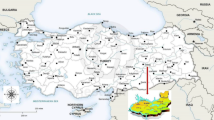Abstract
Airborne pollen grains of Borassus flabellifer were recorded at Madhyamgram, during February to June 1995–1996 commensurate with the plants flowering season. The following year (1996–1997), the exposed Burkard tape segments with the optimal and minimal daily concentrations were divided into two longitudinal equal halves. For each segment, after immunoblotting, one half was incubated with human sera having high IgE titer against Borassus, and the other half with anti-Borassus rabbit sera for the detection of allergen and antigen respectively. Antigen detection was performed by general immunoblotting method, whereas the allergens were detected by chemiluminescence. The occurrence of the pollen grains in air was compared and correlated with that of the allergen and antigen. The number of allergen and antigen spots were always found to be higher than airborne pollen with great size variation due to the presence of exine free protein particles originating from the pollen grains. The number of allergen spots was always lower than the antigen spots. The occurrence of pollen grains and antigen spots showed stronger positive correlation compared with allergen spots. The peak hours for the occurrence of pollen grains, allergens and antigens were recorded. It is evident from this study that the application of direct aeroallergen monitoring method will be highly useful in allergological research.
Similar content being viewed by others
References
Agarwal M.K., Yunginger J.W., Swanson M.C. and Reed C.E.: 1981, An immunochemical method to measure atmospheric allergens. J. Allergy Clin. Immunol. 68, 194–200.
Agarwal M.K., Swanson M.C., Reed C.E. and Yunginger J.W.: 1984, Airborne ragweed allergens: Association with various particle sizes and short ragweed plant parts. J. Allergy Clin. Immunol. 74, 687–693.
Banik S. and Chanda S.: 1992, Airborne pollen survey of Central Calcutta, India, in relation to allergy. Grana 31, 72–75.
Chakraborty P., Gupta-Bhattacharya S. and Chanda S.: 1996, Comparative aerobiology, allergenicity and biochemistry of three palm pollen grains in Calcutta, India. Aerobiologia 12, 47–50.
Ekebom A., Vesterberg O. and Hjelmroos M.: 1996, Detection and quantification of airborne birch pollen allergens on PVDF membranes by immunoblotting and chemiluminescence. Grana 35, 113–118.
Mitra I., Sikdar S. and Chatterjee B.P.: 1992, Effects of chemical reagents on the allergenicity of house dust. Biochemistry International 26, 25–30.
Mygind P., Dahl R., Pedersen S. and Thestrup-Pedersen J.: 1996, Essential allergy. Blackwell Science Ltd., p. 88.
Rantio-Lehtimaki A., Viander M. and Koivikko A.: 1994, Airborne birch pollen antigens in different particle sizes. Clin. Exp. Allergy 24, 23–28.
Sambrook J., Fritsh E.F. and Maniatis T.: 1989, Molecular Cloning. A Laboratory Manual (Second Edn.). Cold Spring Harbor Laboratory Press, p. 18.75.
Schumacher M.J., Griffith R.D. and O'Rourke M.K.: 1988, Recognition of pollen and other aeroantigens by immunoblot microscopy. J. Allergy Clin. Immunol. 82, 608–616.
Spieksma F.Th.M., Nikkels B.R. and Dijkman J.A.: 1995, Seasonal appearance of grass pollen allergens in cultural pauci-micronic aerosol of various size fractions. relation with airborne grass pollen concentration. Clin. Exp. Allergy 25, 234–239.
Stytis D.P., Stobo J.D., Fudenberg H. and Wells J.V.: 1982, Basic and Clinical Immunology (Fourth Edn.). Lauge Medical Publ. Maruzen Asia (Ltd.), p. 409.
Takahashi Y., Sakaguchi M., Inouye S., Miyazawa H., Imaoka K. and Katagiri S.: 1991, Existence of exine-free airborne allergen particles of Japanese cedar (Cryptomeria japonica) pollen. Allergy 46, 588–593.
Takahashi Y., Nagoya T., Watanabe M., Inouye S., Sakaguchi M. and Katagiri S.: 1993a, A new method for counting Japanese cedar (Cryptomeria japonica) pollen allergens by immunoblotting. Allergy 48, 94–98.
Takahashi Y., Sakaguchi M., Inouye S., Yasueda H., Shida T. and Katagiri S.: 1993b, Airborne grass pollen antigens in a grassland as studied by immunoblotting with anti-Lol p 1 antibody. Grana 32, 302–307.
Takahashi Y., Nilsson S. and Berggren B.: 1995a, Aeroallergen immunoblotting with human IgE antibody. Grana 34, 347–360.
Takahashi Y., Sasaki K., Nakamura S., Miki-Hiroshige H. and Nitta H.: 1995b, Aerodynamic size distribution of the particles emitted from the flowers of allergologically important plants. Grana 34, 45–49.
Author information
Authors and Affiliations
Corresponding author
Rights and permissions
About this article
Cite this article
Chakraborty, P., Gupta, S., Gupta-Bhattacharya, S. et al. Airborne pollen of Borassus flabellifer: Quantification of allergen and antigen. Aerobiologia 15, 49–55 (1999). https://doi.org/10.1023/A:1007555801812
Issue Date:
DOI: https://doi.org/10.1023/A:1007555801812




